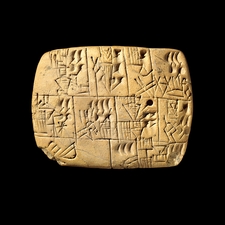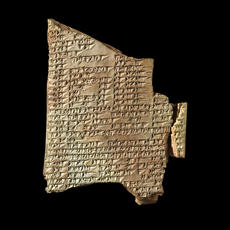Cuneiform script and the Sumerian and Akkadian languages
The Assyrians wrote in a wedge-shaped script now called cuneiform. It consisted of many hundreds of characters representing words and syllables and was very complicated to learn. Cuneiform was used for two completely different languages: Sumerian, which has no known linguistic relatives, and the semitic Akkadian, whose northern dialect was Assyrian.
An ancient tradition

The very first tablets, from the late fourth millenium BC, record numbers (crescent-shaped and circular impressions) and the things being counted. Here jugs of beer are visible, with the sign for 'rations' – a head and a bowl – in the bottom left corner. Photo © The British Museum. View large image on the British Museum's website.
By the 7th century BC, cuneiform writing was already 2,500 years old. It had emerged in the context of temple bureaucracy in the cities of the southern Iraqi marshes some time in the late fourth millennium BC. A tiny number of accountants used word signs (usually pictograms) and number signs to account for institutional assets – land, labour, animals – and their secondary products. They wrote on refined clay tablets, incising the signs for the objects they were recording with a pointed stylus TT and impressing the numbers with a cylindrical one. This writing was barely language-specific – it represented concrete nouns, numbers, and little else, with only occasional clues to pronunciation and none at all to word order – and was known only to a handful of expert users. Its functionality was as yet so limited that it was used only to keep accounts, or to practice writing the words, numbers, and calculations needed for accountancy.
Sumerian: a linguistic isolate
In the course of the third millennium BC, scribes and accountants expanded writing's capabilities to record legal transactions and agreements, dedicatory inscriptions to gods, and, finally, narrative texts of many kinds, including letters, accounts of political events, hymns to deities, and incantations TT . Several innovations were needed to bring this about. Most important was that writing should represent the sounds of words rather than the appearance of objects. At this point, Sumerian becomes visible in the written record. Sumerian is an isolate language whose linguistic relatives, if it ever had any, all died out before they were written down. It is agglutinating: that is, its nouns and verbs are composed of unchanging lexical stems with grammatical particles prefixed and suffixed to them to indicate their function in the sentence. For instance, the phrase ka egalakše ĝenaĝune ("On my arrival at the palace gate") is composed of the particles ka "gate"; e "house", gal "big", ak "of", and še [≈ shay] "at"; ĝen [≈ ngen] "go," a (nominaliser), ĝu [≈ ngoo] "my," and ne (verbal phrase marker).
Conceptual and visual abstraction

This fragmentary tablet from Assurbanipal's Library in Nineveh clearly shows how the cuneiform script is composed of horizontal, vertical and diagonal impressions in the surface of the clay. © The British Museum. View large image on the Cuneiform Digital Library Intative website.
The earliest script had been capable only of writing the lexical stems in this phrase – ka , egal , and perhaps ĝen – but now punning allowed grammatical particles to be written down for the first time. It thus became essential to write signs in a linear order, both to show which stem particles were attached to and to indicate the order of the words in the sentence. Not so essentially, but perhaps inevitably, as writing came to represent sounds rather than objects, it became more abstract in appearance too. The scribes developed a new technique of sign formation which entailed pressing a length of reed stylus obliquely into the clay to create linear strokes or wedges; hence our name "cuneiform" from Latin cuneus, "wedge."
Akkadian: a semitic language
Paradoxically, the tailoring of early writing to the grammatical particularities of Sumerian also freed it from the necessity of writing Sumerian alone. If signs represented sounds, they could represent the sounds of any language, with some adaptations if necessary. Sumerian's closest neighbour was Akkadian, an indirect ancestor of Hebrew and Arabic, which today we subdivide into Assyrian, the dialect of ancient northern Iraq, and Babylonian, the dialect of the south. Like all other Semitic languages, Akkadian works on the principle that three root consonants contain the core lexical meanings of words, and that prefixes, suffixes, and infixes around them contain grammatical information about the word's function in a sentence. So "On my arrival at the palace gate", ina kašādia ana bāb ekalli , is structured very differently to its Sumerian equivalent. First, there are the prepositions ina "on, when" and ana "at, to". In the second word, the consonants k, š [≈ sh], and d represent "arriving" somewhere or "achieving" something; the long ā and the short a between them indicate that its grammatical function is an infinitive or gerund ("to arrive" or "arriving"); and the suffix ia means "my". Finally, there are the nouns bāb "gate" and ekalli "of the palace", which is a loan from the Sumerian egal plus a genitive (belonging) suffix i "of". As well as š , Akkadian also had the consonants ṣ [≈ hard s] and ṭ [≈ hard t] but it did not use f, v, x, Sumerian ĝ, or (as far as we know) the vowel o.
Literacy and numeracy

Two scribes, one with a writing-board and one with a scroll, enumerate booty and slain enemies after battle; detail of the stone decoration of Assurbanipal's Southwest Palace in Nineveh (court XIX, panel 12; BM ANE 124825). Photo by Eleanor Robson. View large image.
Cuneiform writing was fully functional by about 2400 BC but remained the preserve of the professionally literate and numerate who were employed by temples and palaces to uphold and manage institutional authority. Later on, prosperous families and individuals also began to use the services of scribes to record legal transfers of property on marriages, adoptions, and deaths, loans and sales, and the resolution of legal disputes. Cuneiform remained fearsomely complex with some 600 signs in its repertoire, many of which could take one of up to a dozen different syllabic or logographic values depending on context. It was potentially susceptible to simplification, but in fact grew in complexity over the centuries, ensuring that its use remained almost exclusively in the hands (and the eyes) of highly trained scribes. In early Mesopotamia cuneiform literacy had been primarily a tool for controlling the ownership and rights to assets and income, but with the spread of alphabetic Aramaic in the early first millennium BC it increasingly became a prestige medium. With cuneiform, the scribes communicated with the gods, learned and created intellectual culture, and wrote certain sorts of legal documents. The last known datable cuneiform tablet is an astronomical almanac from 75 AD but it may have survived a little later than that.
Signs and syllables
A scribe writing the phrase ina kašādia ana bāb ekalli in cuneiform script might divide each word into syllables, which modern cuneiformists would transliterate (that is, represent alphabetically) as: i-na ka-ša-di-ia a-na ba-ab e-kal-li. A Neo-Assyrian scribe, though, would have been more likely to use a mixture of syllables and logograms (that is, signs which function rather like Sumerian lexical bases). In transliterations, the logograms are written in capital letters, separated by periods: i-na KUR-ia a-na KÁ.GAL-li. The purpose of alphabetic transliteration is to represent the way Sumerian and Akkadian were written with cuneiform signs, so acute and grave accents, and also subscript numerals, are used to distinguish between visually distinct signs that represent the same sound. For instance, over the three thousand years of cuneiform culture there were fourteen different ways of writing the syllable ka – not all of them in use at the same time – which are distinguished in transliteration by notations such as ka, kà (or ka3), and ka8. By contrast, alphabetic normalisation (also called transcription), ignores the writing system. The normalisation ina kašādia ana bāb ekalli gives a rough idea of how the Akkadian sounded - which syllables were short and which were long - but says nothing about what it looked like in cuneiform. Both are useful, but most cuneiformists use transliteration much more than normalisation.
When transliterating a tablet it is also important to show which signs are missing and which damaged. Sometimes the modern editor can conjecturally restore the missing text, like this: [ba-ab]; otherwise the gap is represented as [. . .] or [x x]. Cuneiform signs that are damaged or difficult to read are usually surrounded by the upper half of square brackets but because those symbols are difficult to represent online, here we use o instead: o ba-ab o. Other transliteration conventions include a small exclamation mark ! following a badly written cuneiform sign and x to represent one that is indecipherable: ba!-x.
A lingering death
Written language often has a complex relationship to spoken language, especially in societies with restricted literacy. Just as Latin lingered on in Europe as a scholarly and liturgical language for many centuries after it was last spoken as a mother tongue, hymns were still composed in Sumerian until at least 200 BC, over 1500 years since it had ceased to be a living language. And in the Neo-Assyrian period, it is likely that Aramaic was spoken at least as widely as Akkadian. No-one in the world has been brought up as a native Akkadian-speaker for the last two millennia or more.
Further reading
- Michalowski, 'Writing and literacy', 1994
- Pearce, 'Scribes and scholars', 1995
- Vanstiphout, 'Memory and literacy', 1995
- Walker, Cuneiform, 1987
Eleanor Robson
Eleanor Robson, 'Cuneiform script and the Sumerian and Akkadian languages', Knowledge and Power, Higher Education Academy, 2024 [http://oracc.museum.upenn.edu/saao/knpp/essentials/cuneiformscript/]